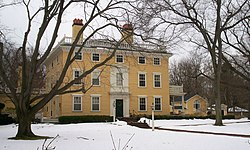Elmwood | |
 Elmwood, December 2008 | |
| Location | 33 Elmwood Avenue, Cambridge, Massachusetts |
|---|---|
| Coordinates | 42°22′31.7″N 71°8′18.2″W / 42.375472°N 71.138389°W |
| Built | 1767 |
| Architect | Thomas Oliver |
| Architectural style | Georgian |
| NRHP reference No. | 66000364[1] |
| Significant dates | |
| Added to NRHP | October 15, 1966 |
| Designated NHLD | December 29, 1962 |
Elmwood, also known as the Oliver-Gerry-Lowell House,[2] is a historic house and centerpiece of a National Historic Landmark District in Cambridge, Massachusetts. It is known for several prominent former residents, including: Thomas Oliver (1734–1815), royal Lieutenant Governor of Massachusetts; Elbridge Gerry (1744–1814), signer of the US Declaration of Independence, Vice President of the United States and eponym of the term "gerrymandering"; and James Russell Lowell (1819–1891), noted American writer, poet, and foreign diplomat.
The house, originally on a 100-acre estate, was built in the Georgian style about 1767 by John Nutting for Lt. Governor Thomas Oliver, member of a wealthy merchant family in the Province of Massachusetts Bay. Abandoned by the Loyalist Oliver at the outset of the American Revolutionary War, the property was confiscated by the state of Massachusetts. It was purchased by Elbridge Gerry, who used it as his family residence until his death in 1814. The house was sold by his heirs to the Lowell family, and was the birthplace and residence of James Russell Lowell for most of his life. During Lowell's ownership significant portions of the original estate were sold off, and his heirs sold the house to art historian and Harvard professor, Arthur Kingsley Porter. He bequeathed the property to the university, which now uses it as the official residence of its president.
Architecturally the house has retained most of its Georgian character, and has had only modest exterior additions and modifications. Although it was decorated in a Victorian style by the Lowells, Harvard restored the interior to a more traditional Georgian style when it took over the property. The house is not open to the public. In addition to the property owned by Harvard, the National Historic Landmark District encompasses the adjacent Lowell Park, a state-owned park which was once part of the original Oliver estate.
- ^ "National Register Information System". National Register of Historic Places. National Park Service. January 23, 2007.
- ^ Wilson, p. 112

